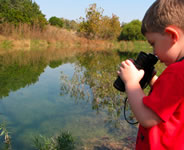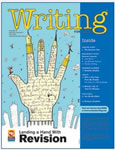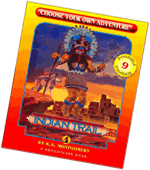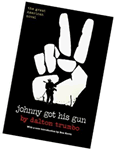

Combine collaborative technologies with effective teaching strategies to promote critical and creative thinking. From WebQuests to technology-enhanced Literature Circles, young people can become creators and contributors along with consumers of the Web. Use collaborative documents, concept maps, and wikis along with other technology to bring literature and learning alive.
In 1956, Rachel Carson published an essay titled "Help Your Child to Wonder." While her focus was enhancing the connection young people have with nature, her approach can be applied to all areas of learning and life.
An investment of a few dollars in a good hand lens or magnifying glass will bring a new world into being.. a patch of moss reveals a dense tropical jungle. - Rachel Carson
Young people need tools they can use to examine and record their world. For instance, a sketchbook and digital camera can help students record science experiences.




Read An Egg Is Quiet by Dianna Aston and Sylvia Long for children or Animal Architects: Building and the Evolution of Intelligence by James L. Gould and Carol Grant Gould for young adults. These books investigate the natural world and encourage young people to wonder and ask questions. Rather than copying from Wikipedia and writing a traditional report, think of more effective ways for students to use technology to share their insights and deep understandings. Get young people to share their excitement about learning by becoming wiki builders.
Move young people from being simply CONSUMERS of the Internet to CREATORS of the Web. Students are consumers when they learn about animal habitats by using The Smithsonian's Conservation Central website. This is a great way to learn, but let's go one step further and get them involved with reading, writing, and creating their own web pages.
Visit The Home of Sylvie, a coho salmon, whose life story has been dramatizing by the fourth and fifth graders of Harborview Elementary School. Students learned about the coho salmon and created a fact-based wiki. Wiki means "quick-quick" in Hawaiian. Creators can build and edit wikis very quickly. The technology is simple.
Visit Ancient Greece for an example of a project that includes a variety of student produced work and use of the discussion tool.
Before jumping into a wiki project, consider your reasons. Beyond the fact that it's "cool," why wiki?
Watch the wiki video from Common Craft and YouTube.
Go to Goofy Global News. Notice the way the project directions are provided on the entry page. Student are required to post their own pages as well as evaluate peer projects.
Go to Catastophe. What directions would young people need to be successful with this project?
Try Iwiki
Open the Travel The USA! wiki.
Each person will choose a different state for the advertising campaign.
To save time, we'll use Wikipedia for information and Wikimedia Commons for pictures. To save a picture, right-click the graphic and choose SAVE PICTURE AS. Then, upload it to the wiki page.
Then, explore the work of your classmates. Use the discussion tab to write a comment.
If a child is to keep alive his inborn sense of wonder... He needs the companionship of at least one adult who can share it, rediscovering with him the joy, excitement and mystery of the world we live in. - Rachel Carson
 Share your passion for exploration by creating assignments that are engaging. Model reading and writing.
Share your passion for exploration by creating assignments that are engaging. Model reading and writing.
Read Peter and the Starcatchers by Dave Berry and Ridley Pearson or other books about pirates. Fourth through sixth graders participated in a Pirates wiki called arrrpirates. Young people not only worked on their own pages, but they also linked to the work of their classmates.
Seek out ways to collaborative around the world:
Many teachers and students dislike collaborative work. Yet we know these skills are critical in today's workforce. Look for ways to enhance collaborative skills through specific, standards-based activities.
Read Teach Collaborative Revision with Google Docs. This article provides tips and checklists for incorporating buddy writing in the classroom using Google Docs. These ideas could also be applied to the creation of wikis. Also, go to the READING and WRITING magazine blog for other ideas.
The lasting pleasures of contact with the natural world are not reserved for scientists but are available to anyone who will place himself under the influence of earth, sea and sky and their amazing life. - Rachel Carson

 Not all children are drawn to the same content. Provide young people with a wealth of opportunities and choices. Bring kids together with a unifying theme. Help them in seeing the connections. Then, create synergy.
Not all children are drawn to the same content. Provide young people with a wealth of opportunities and choices. Bring kids together with a unifying theme. Help them in seeing the connections. Then, create synergy.
Go to the Civil War Literature Wiki. Notice that students have choice. They are also involved with integrating their ideas with the materials developed by others.
Go to WikiLit for a list of literature-rich projects.
Common Wiki Project Pages:
It is more important to pave the way for the child to want to know than to put him on a diet of facts he is not ready to assimilate. - Rachel Carson
The inquiry-based WebQuest approach works great for wiki projects. Provide a page that provides a motivating introduction to the assignment, an overview of the task, specific steps in the process with necessary scaffolding and resources, evaluation criteria, and a conclusion.
Go to Banned Books and English Biz. Notice how the entry page contains the WebQuest. Students can then add their project page to the navigation bar on the left. Both projects involve use of the DISCUSSION tab for student interaction.
Go to the Holocaust Wiki Project. This AP history project by Dan McDowell is a wonderful example of adapting the WebQuest concept to a wiki environment. Young people are presented with an overview, background information, project simulation information, and resources. They can also view projects from other classes: Period 1, Period 2, Period 3, Period 4. There's also an About this Project for teachers. For more ideas, check out his Wiki Adventures site.
Go to some other examples of Wiki WebQuests:
It is not half so important to know as to feel. If facts are the seeds that later produce knowledge and wisdom, then the emotions and the impressions of the senses are the fertile soil in which the seeds must grow. - Rachel Carson

Balance assignments that involve critical thinking with those that engage young people in creative thinking.
Go to the Read Write Wiki wikispace. Explore each project. Choose one to try.
 The key to an effective wiki writing project is creating a positive, supportive environment for writing. Go to Annette Griessman's blog on Writing Good Fiction. It contains some wonderful story starters, and ideas for getting started with plot, setting, characters. Think about ways to incorporate student brainstorming and creative writing into your own wiki project.
The key to an effective wiki writing project is creating a positive, supportive environment for writing. Go to Annette Griessman's blog on Writing Good Fiction. It contains some wonderful story starters, and ideas for getting started with plot, setting, characters. Think about ways to incorporate student brainstorming and creative writing into your own wiki project.
Check out the Young Illustrator Wiki and Screen Plays and Wordless Books wiki.
Explore Characters in Literature and Settings in Literature. Edit one of these to include specific activities, assessments, and examples.
Read a Choose Your Own Adventure book such as Indian Trail. Go to the Choose Your Own Adventure official website. Go to the R.A. Montgomery's Author Blog that lots of information about writing. You can read secret online endings for many of your favorite CYOA books.
Go to the Choose Your Own Adventure wikispace. Add your own adventure!
... becoming receptive to what lies all around you. It is learning again to use your eyes, ears, nostrils and finger tips, opening up the disused channels of sensory impression. - Rachel Carson
Use wikis to organize original information. Think of the wide range of multi-sensory information that can be collected and shared. What are all the ways you can share your understanding of a person, place, thing, or idea?
Explore Young Illustrators, The Wright 3, and Insects projects. Also go to Wiki World for lots of other examples.
Go to the CSI: Cemetery Scene Investigation wikispace and the Weathering wikispace. Students used this wiki to organize information they collected at the local cemetery including notes, photographs, gps coordinates, and other ways of recording the place. They also conducted research on burials. Then, they created a website for the final project.
Read the lesson A Collaboration of Sites and Sounds: Using Wikis to Catalog Protest Songs. This high school project involves students in connecting literature such as To Kill a Mockingbird to social, political, and economic justice issues of a particular time period. This lesson contains lots of worksheets, guidelines, and resources. Check out the wiki rubric (PDF) and project guidelines (PDF). Resources include Wikipedia: Protest Songs and Ontario Coalition Against Poverty. Use the Protest Songs wiki and sample page as an example.
Use wikis as a tool for electronic portfolios. Check out Helen C. Barrett's wikispaces project.
If a child asked me a question that suggested even a faint awareness of the mystery behind the arrival of a migrant sandpiper on the beach of an August morning, I would be far more pleased than by the mere fact that he knew it was a sandpiper and not a plover. - Rachel Carson
 Make reading and writing connections across the curriculum. Go to Day Drives and Humpback Whales for an idea.
Make reading and writing connections across the curriculum. Go to Day Drives and Humpback Whales for an idea.
World Culture 7th Hour and World Culture 8th Hour - students write a story that include longitude and latitude, the ask reader to identify the locations. For instance, Sarah does a Criminal Pursuit Around the World story and Jacob writes a riveting story about a lost suitcase. These assignments combine writing, World Culture, and Geography.
World War I: Poetry Visualization Project - Students read Johnny Got His Gun by Dalton Trumbo (1938). Students write a poem from the perspective of a WWI soldier incorporating historical photos.
Be sure to check out the wide range of teacher wikis too. Explore the Wordless Works wiki on wordless books. Add your favorites.
If you have the resources, consider installing open-source wiki software on your own server. If not, try one of the following services:
Want to learn more? Go to Wiki World.